Discover 35 hidden attractions, cool sights, and unusual things to do in Athens (Greece). Don't miss out on these must-see attractions: Acropolis, Parthenon, and National Archaeological Museum. Also, be sure to include Acropolis Museum in your itinerary.
Below, you can find the list of the most amazing places you should visit in Athens (Attica).
Table of Contents
Acropolis
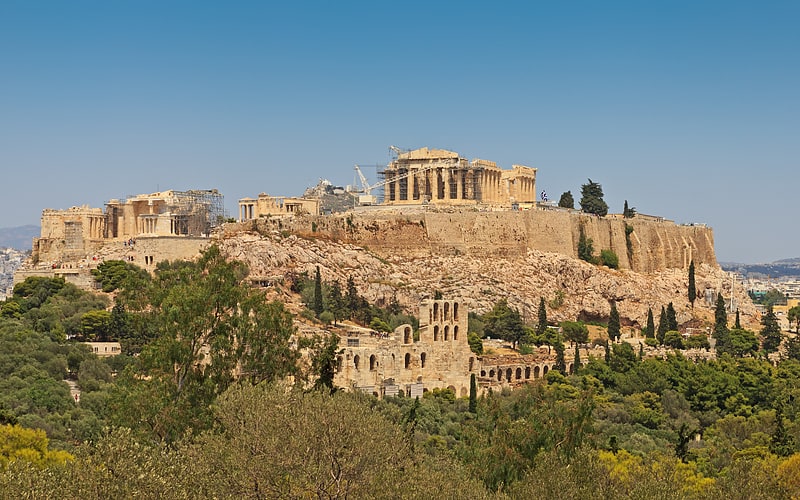
Also known as: Ακρόπολη Αθηνών
5th-century B.C. hilltop temple monument. The Acropolis of Athens is an ancient citadel located on a rocky outcrop above the city of Athens and contains the remains of several ancient buildings of great architectural and historical significance, the most famous being the Parthenon. The word acropolis is from the Greek words ἄκρον and πόλις. The term acropolis is generic and there are many other acropoleis in Greece. During ancient times the Acropolis of Athens was known also more properly as Cecropia, after the legendary serpent-man, Cecrops, the supposed first Athenian king.
While there is evidence that the hill was inhabited as far back as the fourth millennium BC, it was Pericles (c. 495–429 BC) in the fifth century BC who coordinated the construction of the buildings whose present remains are the site's most important ones, including the Parthenon, the Propylaea, the Erechtheion and the Temple of Athena Nike. The Parthenon and the other buildings were seriously damaged during the 1687 siege by the Venetians during the Morean War when gunpowder being stored in the Parthenon by the Ottomans was hit by a cannonball and exploded.[1]
Address: Ακρόπολη Αθηνών, Athens (Αθήνα 1)
Parthenon
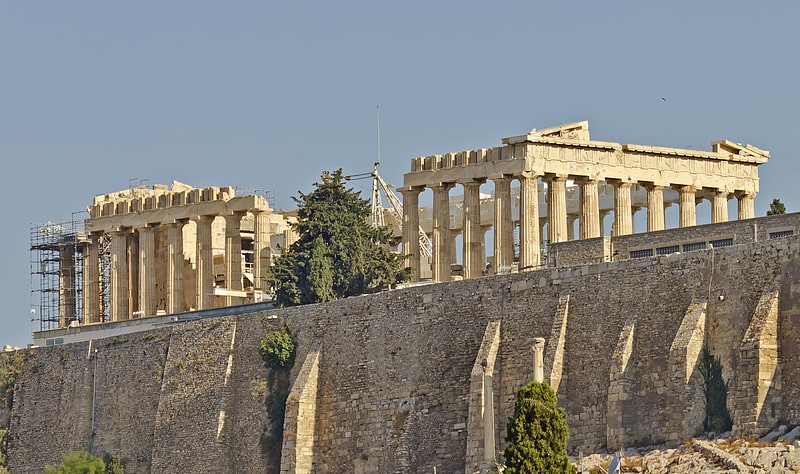
Also known as: Παρθενώνας
Iconic 5th BC Athenian temple ruins. The Parthenon is a former temple on the Athenian Acropolis, Greece, dedicated to the goddess Athena, whom the people of Athens considered their patroness. Construction started in 447 BC when the Delian League was at the peak of its power. It was completed in 438 BC, although decoration of the building continued until 432 BC. It is the most important surviving building of Classical Greece, generally considered the zenith of the Doric order.
For a time, it served as the treasury of the Delian League, which later on became the Athenian Empire. In the final decade of the 6th century AD, the Parthenon was converted into a Christian church dedicated to the Virgin Mary. After the Ottoman conquest, the Parthenon was turned into a mosque in the early 1460s. On 26 September 1687, an Ottoman ammunition dump inside the building was ignited by Venetian bombardment during a siege of the Acropolis. The resulting explosion severely damaged the Parthenon and its sculptures. From 1800 to 1803, The 7th Earl of Elgin removed some of the surviving sculptures, now known as the Elgin Marbles, reportedly with the permission of the Turks of the Ottoman Empire.
The Parthenon itself replaced an older temple of Athena, which historians call the Pre-Parthenon or Older Parthenon, that was demolished in the Persian invasion of 480 BC. Like most Greek temples, the Parthenon served a practical purpose as the city treasury. Its decorative sculptures are considered some of the high points of Greek art. The Parthenon is regarded as an enduring symbol of Ancient Greece, democracy and Western civilization, and one of the world's greatest cultural monuments. To the Athenians who built it, the Parthenon, and other Periclean monuments of the Acropolis, were seen fundamentally as a celebration of Hellenic victory over the Persian invaders and as a thanksgiving to the gods for that victory. Since 1975, numerous large-scale restoration projects have been undertaken to ensure the structural stability of the temple.[2]
Address: Ακρόπολη Αθηνών, Athens (Αθήνα 1)
National Archaeological Museum
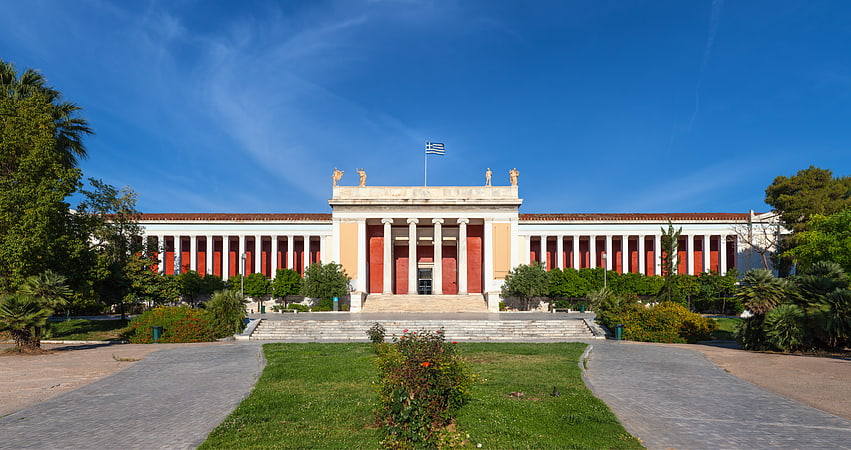
Also known as: Εθνικό Αρχαιολογικό Μουσείο
Ancient Greek art and archaeology museum. The National Archaeological Museum in Athens houses some of the most important artifacts from a variety of archaeological locations around Greece from prehistory to late antiquity. It is considered one of the greatest museums in the world and contains the richest collection of Greek Antiquity artifacts worldwide. It is situated in the Exarcheia area in central Athens between Epirus Street, Bouboulinas Street and Tositsas Street while its entrance is on the Patission Street adjacent to the historical building of the Athens Polytechnic university.[3]
Address: 28is Oktovriou 44, 106 82 Athina (Αθήνα 1)
Acropolis Museum
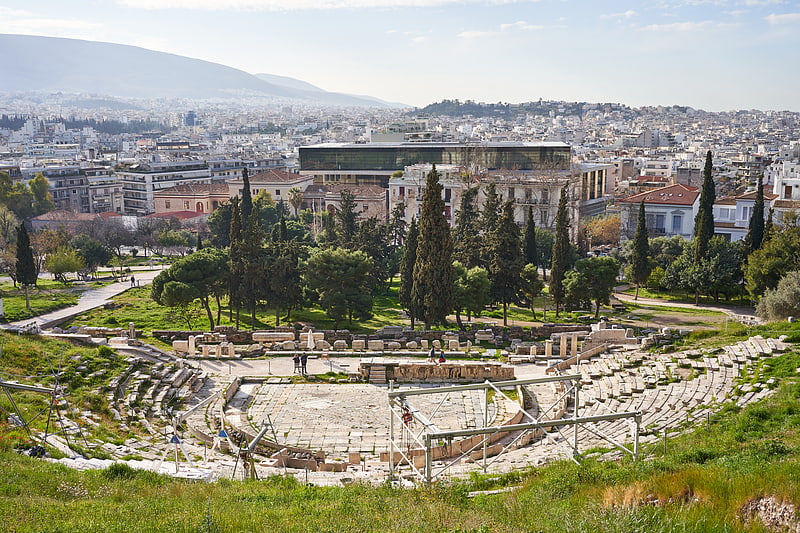
Also known as: Μουσείο Ακρόπολης
Museum in Athens, Greece. The Acropolis Museum is an archaeological museum focused on the findings of the archaeological site of the Acropolis of Athens. The museum was built to house every artifact found on the rock and on the surrounding slopes, from the Greek Bronze Age to Roman and Byzantine Greece. It also lies over the ruins of part of Roman and early Byzantine Athens.
The museum was founded in 2003 while the Organization of the Museum was established in 2008. It opened to the public on 20 June 2009. More than 4,250 objects are exhibited over an area of 14,000 square metres. The Organization for the Construction of the new museum is chaired by Aristotle University of Thessaloniki Professor Emeritus of Archaeology, Dimitrios Pandermalis.[4]
Address: Διονυσίου Αρεοπαγίτου 15, 117 42 Αθήνα (Αθήνα 1)
Temple of Athena Nike
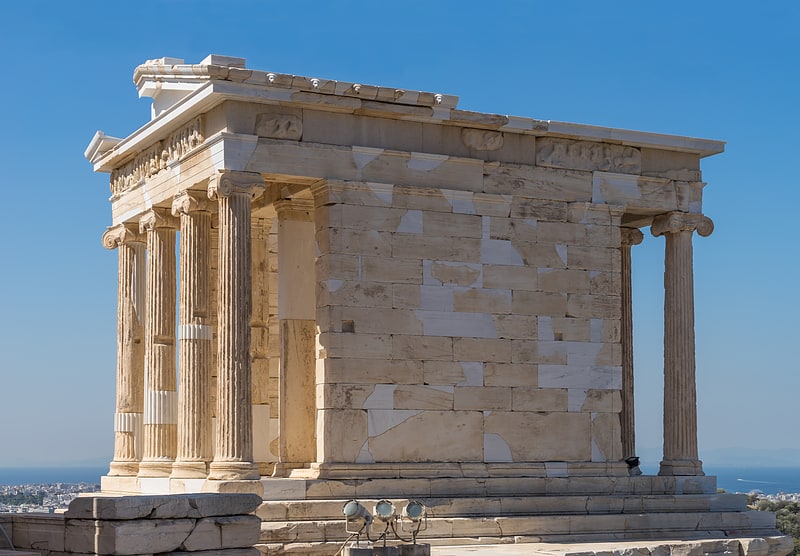
Also known as: Ναός Αθηνάς Νίκης
Ionic temple depicting a Greek goddess. The Temple of Athena Nike is a temple on the Acropolis of Athens, dedicated to the goddesses Athena and Nike. Built around 420 BC, the temple is the earliest fully Ionic temple on the Acropolis. It has a prominent position on a steep bastion at the south west corner of the Acropolis to the right of the entrance, the Propylaea. In contrast to the Acropolis proper, a walled sanctuary entered through the Propylaea, the Victory Sanctuary was open, entered from the Propylaea's southwest wing and from a narrow stair on the north. The sheer walls of its bastion were protected on the north, west, and south by the Nike Parapet, named for its frieze of Nikai celebrating victory and sacrificing to their patroness, Athena and Nike.
Nike was the goddess of victory in Greek mythology, and Athena was worshipped in this form, representative of being victorious in war. The citizens worshipped the goddesses in hopes of a successful outcome in the long Peloponnesian War fought against the Spartans and allies.[5]
Address: Ακρόπολη Αθηνών, Athens (Αθήνα 1)
Voukourestiou Street

Also known as: Οδός Βουκουρεστίου
Street in Athens, Greece. Voukourestiou Street named after the 1913 Treaty of Bucharest, which ended the Second Balkan War, is a rather narrow street in the Kolonaki district of Athens known for its high-end boutiques. In the 1950s, the street became popular for hip and trendy European and American goods in the Greek capital as well as gold and jewellery shops. Running from Stadiou Street to the slope of Mount Lycabettus, the street epitomized fancy shopping in Greece for generations.
Voukourestiou Street is one of the four streets which enclose the large building of the former Army Shareholders' Fund. Now the building houses the Attica Department Store and the headquarters of the Piraeus Bank. Among others, there are a spa, three theatres and three cafés and restaurants, one of which is the well-known café Zonars. The building is crossed by an arcade which connects Voukourestiou and Amerikis Streets. This block—recently known as Athens City Link—houses the majority of the high-end boutiques in central Athens.[6]
Odeon of Herodes Atticus
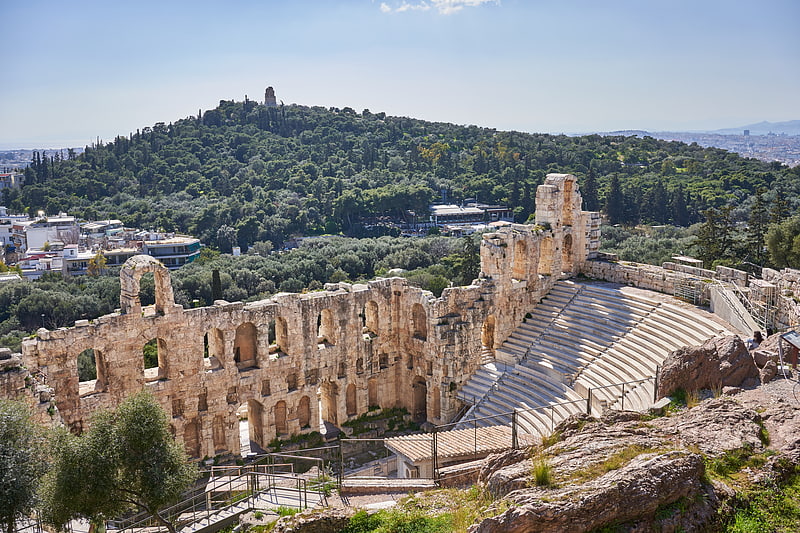
Also known as: Ωδείο Ηρώδου του Αττικού
Ancient stone theater with performances. The Odeon of Herodes Atticus is a stone Roman theatre structure located on the southwest slope of the Acropolis of Athens, Greece. The building was completed in AD 161 and then renovated in 1950.[7]
Erechtheion
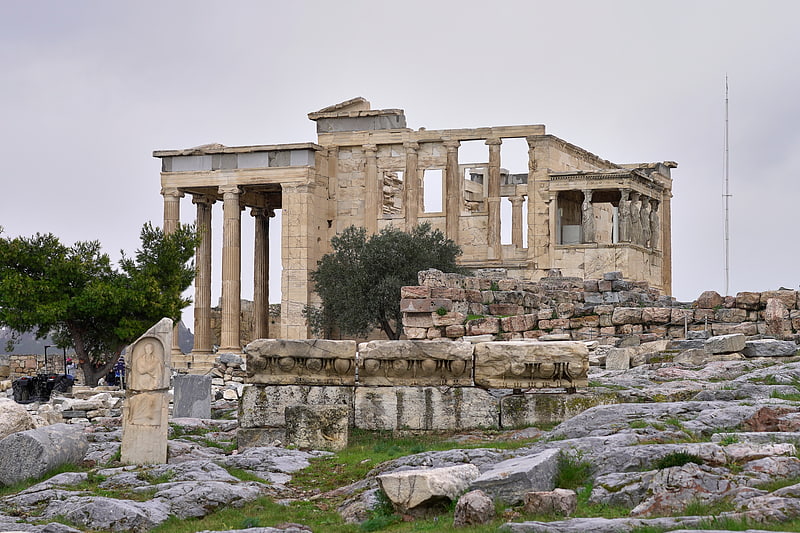
Also known as: Ερέχθειο
Iconic temple of ancient Greece. The Erechtheion or Temple of Athena Polias is an ancient Greek Ionic temple-telesterion on the north side of the Acropolis, Athens, which was primarily dedicated to the goddess Athena. The building, made to house the statue of Athena Polias, has in modern scholarship been called the Erechtheion in the belief that Pausanias' description of the Erechtheion applies to this building. However, whether the Erechtheion referred to by Pausanias is indeed the Ionic temple or an entirely different building has become a point of contention in recent decades.
In the official decrees the building is referred to as “.. το͂ νεὸ το͂ ἐμ πόλει ἐν ο͂ι τὸ ἀρχαῖον ἄγαλμα” (the temple on the Akropolis within which is the ancient statue). In other instances it is referred to as the Temple of the Polias. The joint cult of Athena and Poseidon-Erechtheus appears to have been established on the Acopolis at a very early period, and they were even worshipped in the same temple as may, according to the traditional view, be inferred from two passages in Homer and also from later Greek texts. The extant building is the successor of several temples and buildings on the site. Its precise date of construction is unknown; it has traditionally been thought to have been built from circa 421–406 BC, but more recent scholarship favours a date in the 430s, when it could have been part of the programme of works instigated by Pericles.
The Erechtheion is unique in the corpus of Greek temples in that its asymmetrical composition doesn’t conform to the canon of Greek classical architecture. This is attributed either to the irregularity of the site, or to the evolving and complex nature of the cults which the building housed, or it is conjectured to be the incomplete part of a larger symmetrical building. Additionally, its post-classical history of change of use, damage and spoliation has made it one of the more problematic sites in classical archaeology. The precise nature and location of the various religious and architectural elements within the building remain the subject of debate. The temple was nonetheless a seminal example of the classical Ionic style, and was highly influential on later Hellenistic, Roman and Greek Revival architecture.[8]
Address: Ακρόπολη Αθηνών, Athens (Αθήνα 1)
Choragic Monument of Thrasyllos
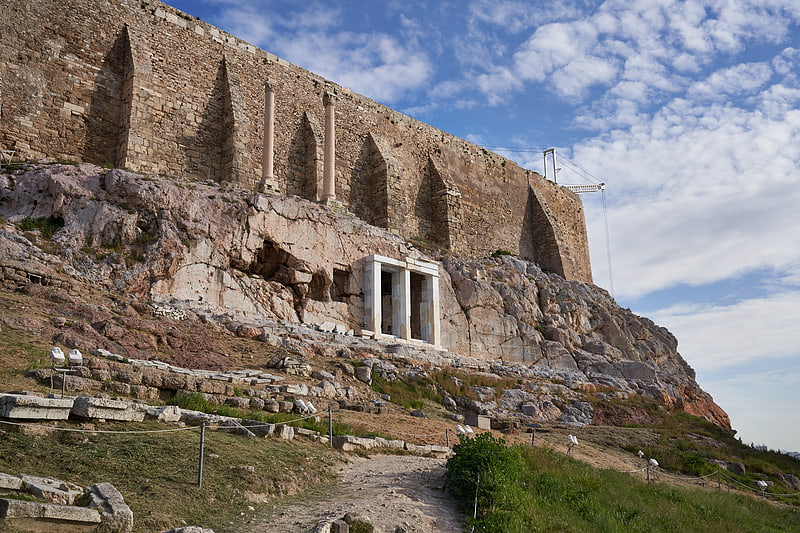
The choragic monument of Thrasyllos is a memorial building erected in 320–319 BCE, on the artificial scarp of the south face of the Acropolis of Athens, to commemorate the choregos of Thrasyllos. It is built in the form of a small temple and fills the opening of a large, natural cave. It was modified in 271/70 by Thrasykles the son of Thrasyllos, agonothetes in the Great Dionysia Games. Pausanias refers to the monument indirectly providing us with the information that in the cave there existed a representation of Apollo and Artemis slaughtering the children of Niobe.
Echoing the west part of the south wing of the Propylaea the facade of the monument is formed by two monumental doorways with antae and a central pillar, door frames, architrave with continuous guttae, frieze and cornice. The frieze was decorated with ten olive wreaths, five on each side of a central wreath while the cornice supported bases for the choragic tripods. It was built in a variety of marbles from local quarries. On the epistyle there was the inscription: Thrasyllos, son of Thrasyllos of Dekeleia, set this up, being choregos and winning in the men's chorus for the tribe of Hippothontis. Euios of Chalkis played the flute. Neaichmos was archon. Karidamos son of Sotios directed. Two subsequent inscriptions were added in the years 270/1 BCE, one reads: The demos was choregos, Pytharatos was archon. Thrasykles, son of Thrasyllos of Dekeleia, was agonothete. Hippothontis won the boys’ chorus. Theon the Theban played the flute. Pronomos the Theban directed. The structure would have been surmounted with three bronze tripods; prizes in the choregia. Stuart and Revett record a statue of Dionysios in place of the original tripods, this was likely a later addition at the time of the repair of the Theatre of Dionysus by Phaidros in the fourth century CE.
Sometime in the Christian period a church was installed in the cave dedicated to Panaghia Spiliotissa. Lord Elgin removed the Hellenistic statue of Dionysos in 1802 as a part of the Elgin Marbles thus the sculpture was spared when the monument was destroyed by an Ottoman bombardment during the siege of Athens in 1827. Although the monument was scheduled to be restored in the nineteenth century by the Athens Archaeological Society some of the marble was recarved and reused on the Byzantine church of Soteira Lykodimou. Recent restoration work began in 2002 and draws largely on the measured drawing by Stuart and Revett undertaken in the eighteenth century. It was through the work of Stuart and Revett and J. D. Le Roy's Ruines des plus beaux monuments de la Grece that the Thrasyllos monument would influence later architecture. Both Karl Friedrich Schinkel and Alexander Thomson adopted the post-and-lintel, trabeated construction of the monument in their work.[9]
Propylaea

Also known as: Προπύλαια
Historical landmark in Athens, Greece. In ancient Greek architecture, a propylaea, propylea or propylaia is a monumental gateway. The prototypical Greek example is the propylaea that serves as the entrance to the Acropolis of Athens. The Greek Revival Brandenburg Gate of Berlin and the Propylaea in Munich both evoke the central portion of the Athens propylaea.[10]
Address: Ακρόπολη Αθηνών, Athens (Αθήνα 1)
Ancient Agora

Also known as: Αρχαία Αγορά της Αθήνας
Iconic Greek ruins with a museum. The ancient Agora of Athens is the best-known example of an ancient Greek agora, located to the northwest of the Acropolis and bounded on the south by the hill of the Areopagus and on the west by the hill known as the Agoraios Kolonos, also called Market Hill. The Agora's initial use was for a commercial, assembly, or residential gathering place.[11]
Address: Αδριανού 24, 105 55 Αθήνα (Αθήνα 1)
Benaki Museum
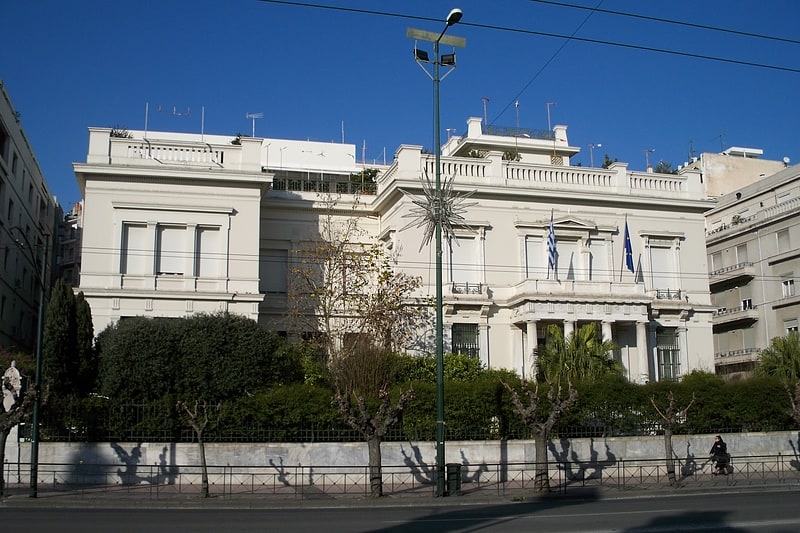
Also known as: Μουσείο Μπενάκη
Museum in Athens, Greece. The Benaki Museum, established and endowed in 1930 by Antonis Benakis in memory of his father Emmanuel Benakis, is housed in the Benakis family mansion in downtown Athens, Greece. The museum houses Greek works of art from the prehistorical to the modern times, an extensive collection of Asian art, hosts periodic exhibitions and maintains a state-of-the-art restoration and conservation workshop. Although the museum initially housed a collection that included Islamic art, Chinese porcelain and exhibits on toys, its 2000 re-opening led to the creation of satellite museums that focused on specific collections, allowing the main museum to focus on Greek culture over the span of the country's history.This Museum in Athens houses over 100,000 artifacts from Greek history and showcases the many eras, civilizations and cultures which have influenced the development of Greece. Spread over a number of locations, the museum ranks among Greece’s foremost cultural institutions.[12]
Address: Κουμπάρη 1, 106 74 Αθήνα (Αθήνα 1)
National Garden
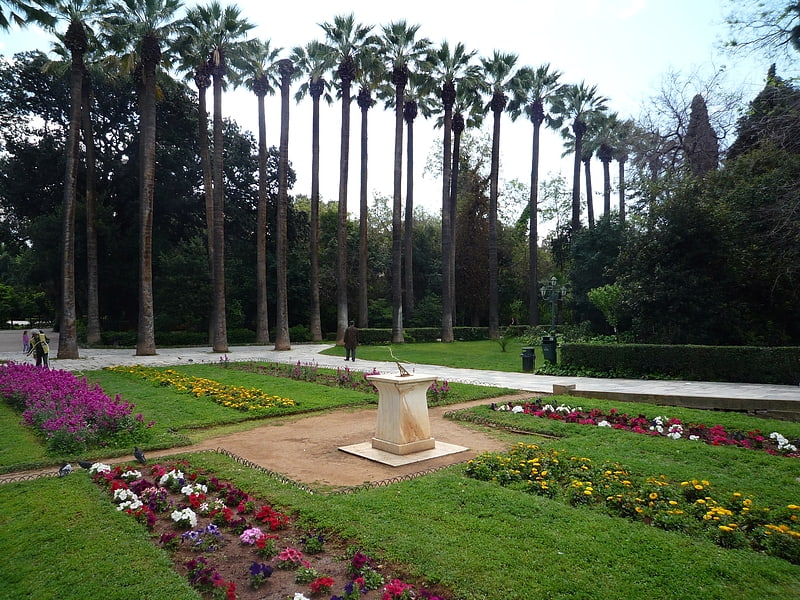
Also known as: Εθνικός Κήπος
Scenic park with archeological remains. The National Garden is a public park of 15.5 hectares in the center of the Greek capital, Athens. It is located between the districts of Kolonaki and Pangrati, directly behind the Greek Parliament building and continues to the South to the area where the Zappeion is located, across from the Panathenaiko or Kalimarmaro Olympic Stadium of the 1896 Olympic Games. The Garden also encloses some ancient ruins, column drums and Corinthian capitals of columns, mosaics, and other features. On the Southeast side are the busts of Ioannis Kapodistrias, the first governor of Greece, and of the Philhellene Jean-Gabriel Eynard. On the South side are the busts of the celebrated Greek poets Dionysios Solomos, author of the Greek National Hymn, and Aristotelis Valaoritis.[13]
Address: Λεωφ. Βασιλίσσης Αμαλίας 1, 105 57 Αθήνα (Αθήνα 1)
Temple of Hephaestus
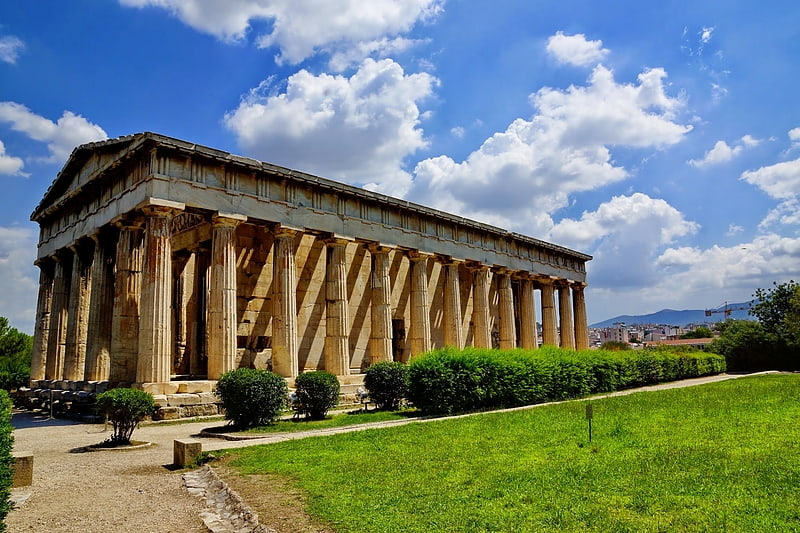
Also known as: Ναός Ηφαίστου
Ancient, hilltop place of worship. The Temple of Hephaestus or Hephaisteion, is a well-preserved Greek temple dedicated to Hephaestus; it remains standing largely intact today. It is a Doric peripteral temple, and is located at the north-west side of the Agora of Athens, on top of the Agoraios Kolonos hill. From the 7th century until 1834, it served as the Greek Orthodox church of Saint George Akamates. The building's condition has been maintained due to its history of varied use.[14]
Address: Αδριανού 24, 105 55 Αθήνα (Αθήνα 1)
Tomb of the Unknown Soldier
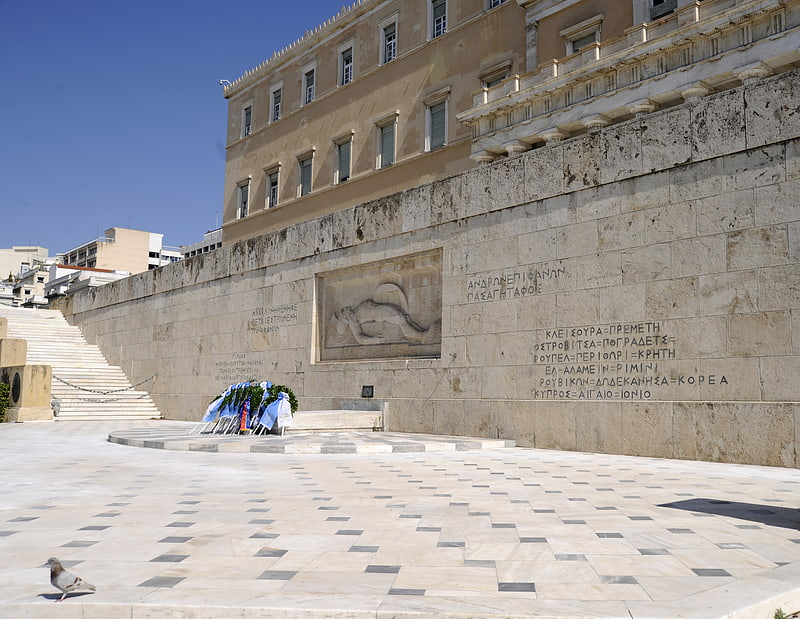
Also known as: Μνημείο του άγνωστου στρατιώτη
Historical landmark in Athens, Greece. The Tomb of the Unknown Soldier is a war memorial located in Syntagma Square in Athens, in front of the Old Royal Palace. It is a cenotaph dedicated to the Greek soldiers killed during war. It was sculpted between 1930 and 1932 by sculptor Fokion Rok.
The tomb is guarded by the Evzones of the Presidential Guard.[15]
Address: Πλατεία Συντάγματος, 105 57 Αθήνα (Αθήνα 1)
Byzantine and Christian Museum
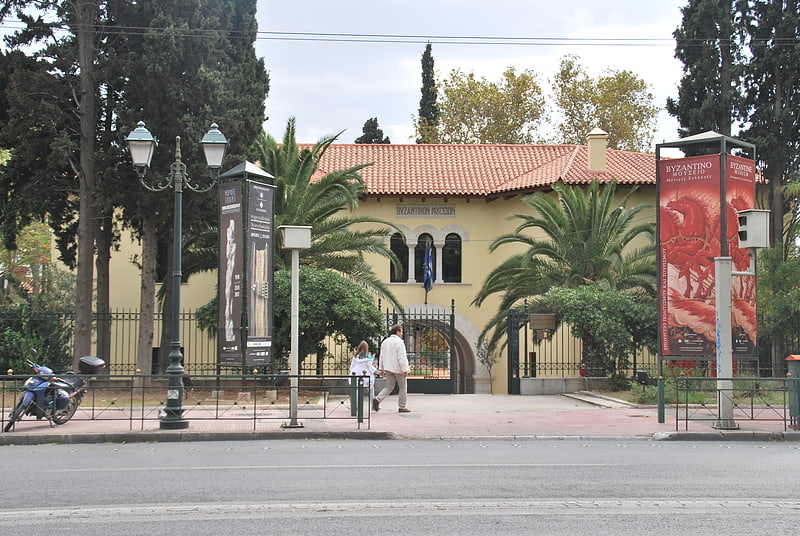
Also known as: Βυζαντινό και Χριστιανικό Μουσείο
Collection of frescoes and artifacts. The Byzantine and Christian Museum is situated at Vassilissis Sofias Avenue in Athens, Greece. It was founded in 1914, and houses more than 25,000 exhibits with rare collections of pictures, scriptures, frescoes, pottery, fabrics, manuscripts, and copies of artifacts from the 3rd century AD to the Late Middle Ages. It is one of the most important museums in the world in Byzantine Art. In June 2004, in time for its 90th anniversary and the 2004 Athens Olympics, the museum reopened to the public after an extensive renovation and the addition of another wing.[16]
Address: Λεωφ. Βασιλίσσης Σοφίας 22, 106 75 Αθήνα (Αθήνα 1)
Daphni Monastery
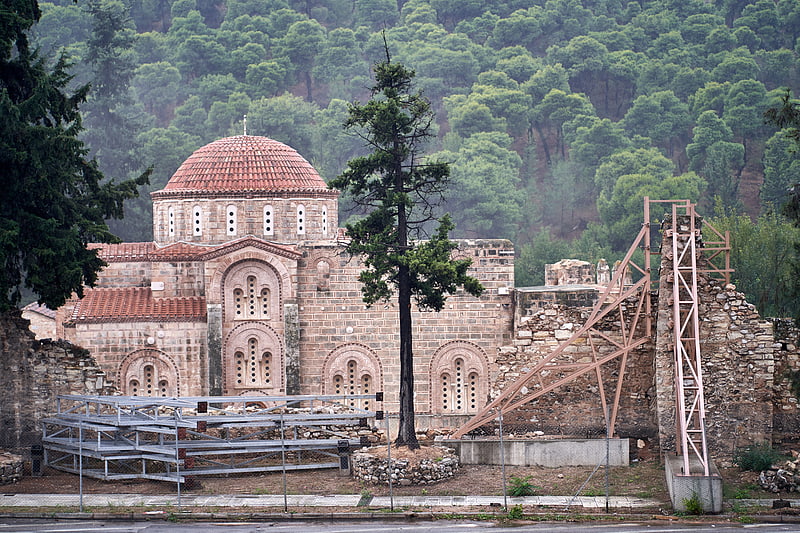
Also known as: Μονή Δαφνίου
Historic monastery with gold mosaics. Daphni or Dafni is an eleventh-century Byzantine monastery eleven kilometers northwest of central Athens in the suburb of Chaidari, south of Athinon Avenue. It is situated near the forest of the same name, on the Sacred Way that led to Eleusis. The forest covers about 18 km2, and surrounds a laurel grove. "Daphni" is the modern Greek name that means "laurel grove", derived from Daphneion.[17]
Address: Leof. Athinon 9178, 124 62 Chaidari
Areopagus
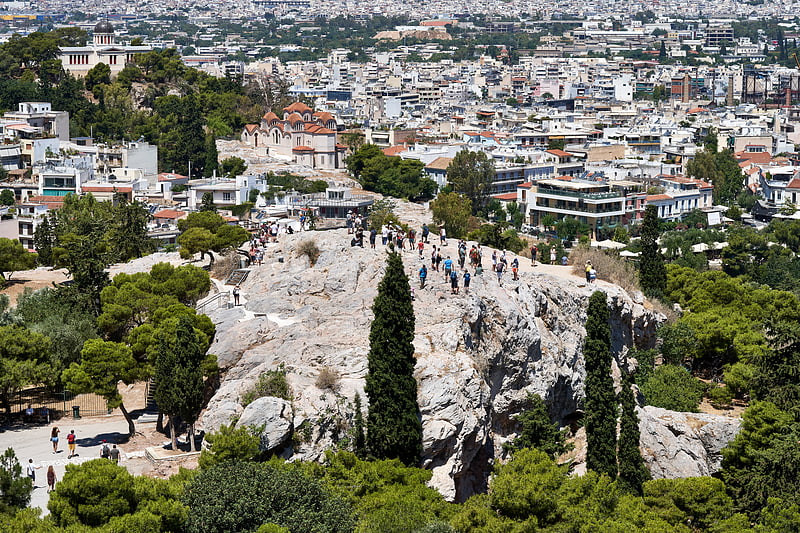
Also known as: Άρειος Πάγος
Rocky hill with a long history. The Areopagus is a prominent rock outcropping located northwest of the Acropolis in Athens, Greece. Its English name is the Late Latin composite form of the Greek name Areios Pagos, translated "Hill of Ares". The name Areopagus also referred, in classical times, to the Athenian governing council, later restricted to the Athenian judicial council or court that tried cases of deliberate homicide, wounding and religious matters, as well as cases involving arson of olive trees, because they convened in this location. The war god Ares was supposed to have been tried by the other gods on the Areopagus for the murder of Poseidon's son Halirrhothius.[18]
Address: Λόφος Αρείου Πάγου, Athens (Αθήνα 1)
Arch of Hadrian
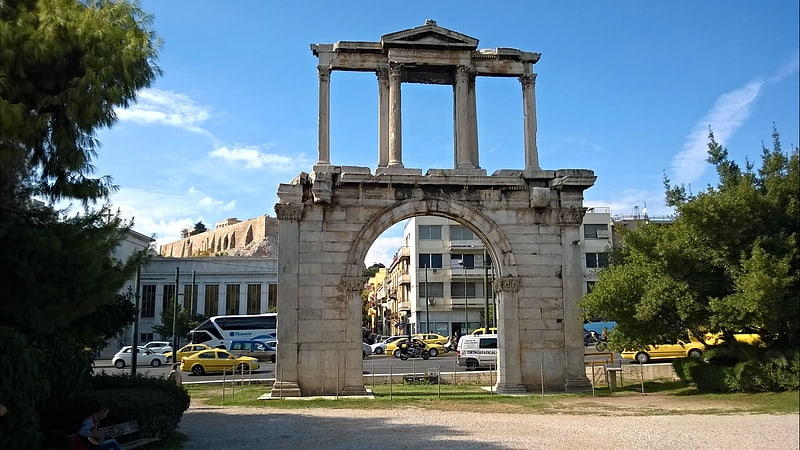
Also known as: Πύλη του Αδριανού
Ancient monumental arched gateway. The Arch of Hadrian, most commonly known in Greek as Hadrian's Gate, is a monumental gateway resembling—in some respects—a Roman triumphal arch. It spanned an ancient road from the center of Athens, Greece, to the complex of structures on the eastern side of the city that included the Temple of Olympian Zeus.
It has been proposed that the arch was built to celebrate the adventus (arrival) of the Roman emperor Hadrian and to honor him for his many benefactions to the city, on the occasion of the dedication of the nearby temple complex in 131 or 132 AD. Since Hadrian had become an Athenian citizen nearly two decades before the monument was built, Kouremenos has argued that the inscriptions on the arch honor him as an Athenian rather than as the Roman emperor. It is not certain who commissioned the arch, although it is probable that it was the citizens of Athens. There were two inscriptions on the arch, facing in opposite directions, naming both Theseus and Hadrian as founders of Athens. While it is clear that the inscriptions honor Hadrian, it is uncertain whether they refer to the city as a whole or to the city in two parts: one old and one new. The early idea, however, that the arch marked the line of the ancient city wall, and thus the division between the old and the new regions of the city, has been shown to be false by further excavation. The arch is located 325 metres (1,066 ft) southeast of the Acropolis.[19]
Address: Λεωφ. Βασιλίσσης Αμαλίας, 105 58 Αθήνα (Αθήνα 1)
Stoa of Attalos
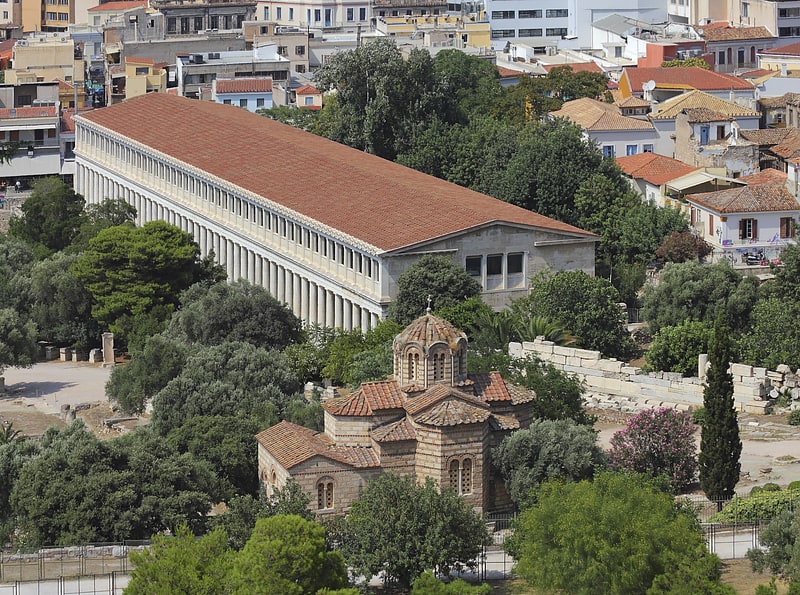
Also known as: Στοά του Αττάλου
Reconstructed building and Athenian museum. The Stoa of Attalos was a stoa in the Agora of Athens, Greece. It was built by and named after King Attalos II of Pergamon, who ruled between 159 BC and 138 BC. The current building was reconstructed from 1952 to 1956 by the American School of Classical Studies at Athens and currently houses the Museum of the Ancient Agora.[20]
Agios Kosmas Olympic Sailing Centre

Also known as: Ολυμπιακό Κέντρο Ιστιοπλοΐας Αγίου Κοσμά
Marina in Elliniko, Greece. The Agios Kosmas Olympic Sailing Centre hosted the sailing events at the 2004 Summer Olympics in Athens, Greece. The center is located about four miles from downtown Athens along the coast. It was officially opened on August 2, 2004, a few weeks before the Olympics, though test events were conducted at the site in August 2002 and 2003. The center had a capacity of 1,600 for the medal ceremonies.
After the Olympics, the site was turned over to the private sector (Seirios AE), and will become a marina with a 1,000+ yacht capacity, as part of Athens' revitalized waterfront.[21]
Tower of the Winds
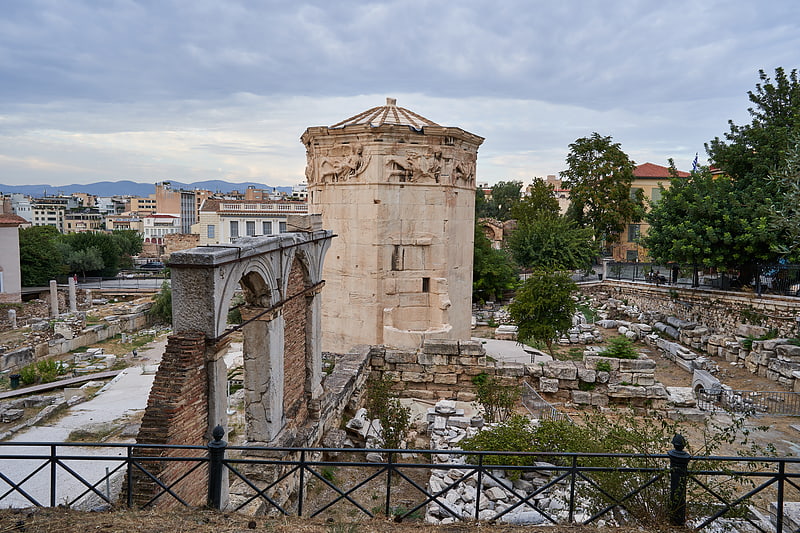
Also known as: Αέρηδες
Ancient tower to indicate weather and time. The Tower of the Winds or the Horologion of Andronikos Kyrrhestes is an octagonal Pentelic marble clocktower in the Roman Agora in Athens that functioned as a horologion or "timepiece". It is considered the world's first meteorological station. Unofficially, the monument is also called Aerides, which means Winds. The structure features a combination of sundials, a water clock, and a wind vane. It was designed by Andronicus of Cyrrhus around 50 BC, but according to other sources, might have been constructed in the 2nd century BC before the rest of the forum. In summer of 2014, the Athens Ephorate of Antiquities began cleaning and conserving the structure; restoration work was completed in August 2016.[22]
Address: Ρωμαϊκή Αγορά, 105 56 Αθήνα (Αθήνα 1)
Mount Lycabettus
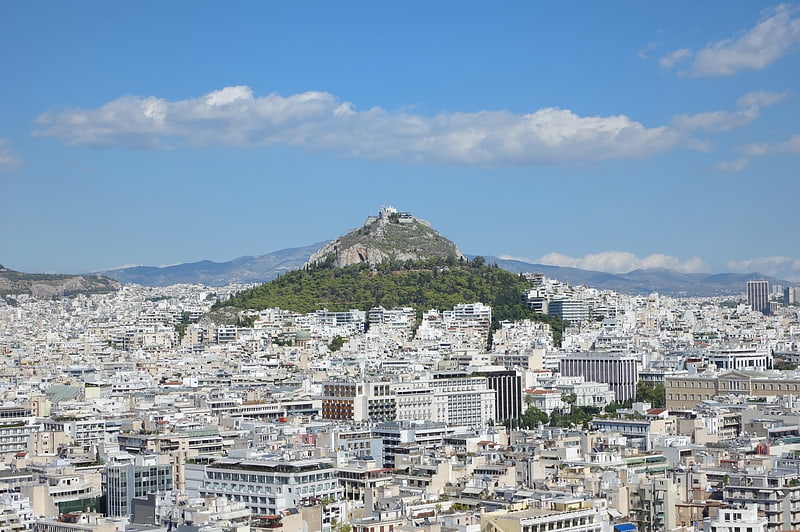
Also known as: Λυκαβηττός
Landmark hill with an amphitheater. Mount Lycabettus, also known as Lycabettos, Lykabettos or Lykavittos, is a Cretaceous limestone hill in the Greek capital Athens. At 277 meters above sea level, its summit is the highest point in Central Athens and pine trees cover its base. The name also refers to the residential neighbourhood immediately below the east of the hill.
The hill is a tourist destination and can be ascended by the Lycabettus Funicular, a funicular railway which climbs the hill from a lower terminus at Kolonaki (The railway station can be found at Aristippou street). At its two peaks are the 19th century Chapel of St. George, a theatre, and a restaurant.[23]
Asklepieion of Athens

The Asklepieion of Athens was the sanctuary built in honour of the gods Asclepius and Hygieia, located west of the Theatre of Dionysos and east of the Pelargikon wall on the southern escarpment of the Acropolis hill. It was one of several asklepieia in the ancient Greek world that served as rudimentary hospitals. It was founded in the year 419–18 BCE during the Peloponnesian War, perhaps as a direct result of the plague, by Telemachos Acharneas. His foundation is inscribed in the Telemachos Monument, a double-sided, marble column which is topped by reliefs depicting the arrival of the god in Athens from Epidaurus and his reception by Telemachos. The sanctuary complex consisted of the temple and the altar of the god as well as two galleries, the Doric Arcade which served as a katagogion for overnight patients in the Asklepieion and their miraculous healing by the god, and the Ionic Stoa that served as a dining hall and lodging for the priests of Asclepius and their visitors.
The Doric Arcade was founded according to inscriptions in 300–299 BCE and was a two-storey building with 17 Doric columns on its facade. This is framed by the sacred spring at its eastern end and a pit lined with masonry at its western end. This source is a small cave in the rock, in which there lies the natural spring. The circular well or pit, a deep hollow with polygonal masonry built into the cliff face, was accessed from the second floor of the Doric Arcade and dates to the last quarter of the 5th century. F Robert proposed that it was a place devoted to the celebration of Heroes in the Asklepeion during ta Heroa, which witnessed sacrifices to the chthonic gods and heroes, as testified epigraphically.
The Ionian Arcade, west of the temple, is also dated to the last quarter of the 5th century. The sanctuary on its west side was enclosed by a propylon for the visitors to access from the ancient promenade to the Asklepieion site. According to epigraphic evidence, the propylon was renovated in Roman times.
At the beginning of the 6th c. CE, when Christian worship succeeded the ancient, all the monuments of Asclepius were demolished and the material incorporated into the complex of a large, three-aisled Early Christian basilica. In the Byzantine years two smaller, single-aisled temples occupied the position of the basilica, while the latter of them functioned as the catholicon of a small monastery. Since 2002, partial restorations of the west end of the ground floor of the Doric Stoa façade, the room of the Sacred Cave on the first floor of the Doric Stoa and the temple of Asclepius have been performed.[24]
Numismatic Museum
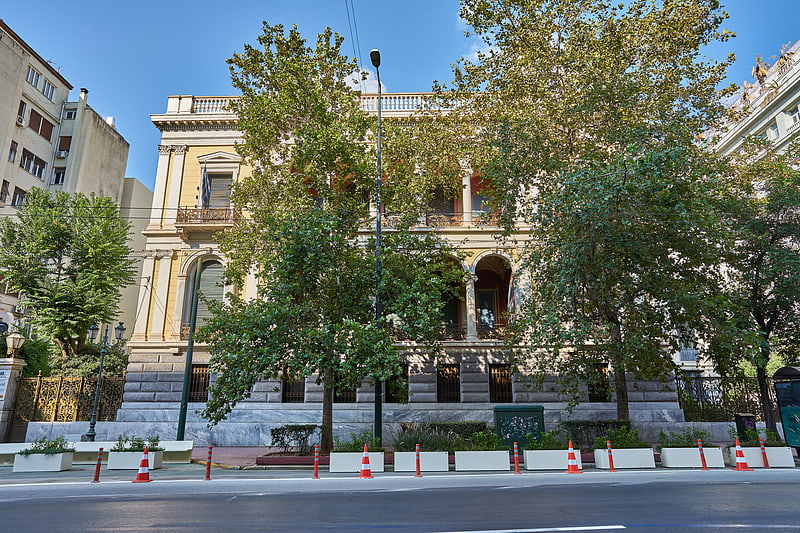
Also known as: Νομισματικό Μουσείο Αθηνών
Coins and medals dating to 1300 B.C.. The Numismatic Museum of Athens is one of the most important museums in Greece and it houses a collection of over 500,000 coins, medals, gems, weights, stamps and related artefacts from 1400BC to modern times. The collection constitutes one of the richest in the world, paralleled by those of the British Museum in London, the Bibliothèque Nationale in Paris, the State Hermitage Museum in St. Petersburg, the Bode Museum in Berlin, and the American Numismatic Society in New York. The museum itself is housed in the mansion of the archaeologist Heinrich Schliemann, formally known as Iliou Melathron.[25]
Address: Ελευθερίου Βενιζέλου 12, 106 71 Αθήνα (Αθήνα 1)
Temple of Olympian Zeus
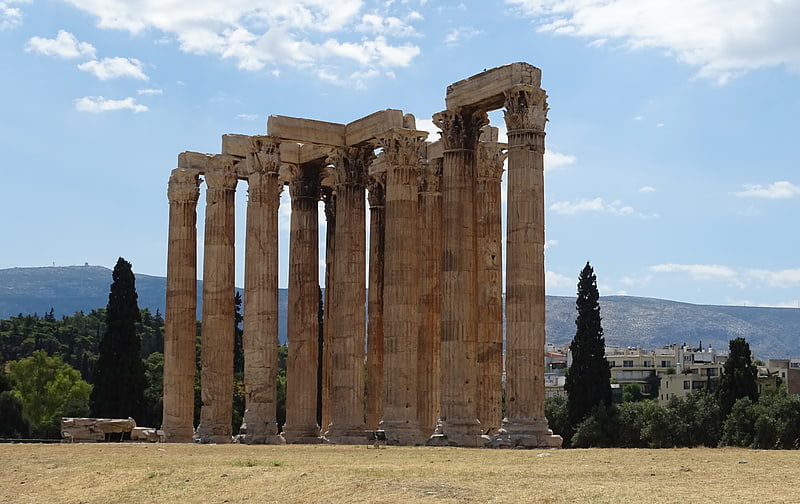
Also known as: Ναός του Ολυμπίου Διός
Ruined temple completed under Hadrian. The Temple of Olympian Zeus, also known as the Olympieion or Columns of the Olympian Zeus, is a former colossal temple at the center of the Greek capital Athens. It was dedicated to "Olympian" Zeus, a name originating from his position as head of the Olympian gods. Construction began in the 6th century BC during the rule of the Athenian tyrants, who envisaged building the greatest temple in the ancient world, but it was not completed until the reign of the Roman Emperor Hadrian in the 2nd century AD, some 638 years after the project had begun. During the Roman period the temple, which included 104 colossal columns, was renowned as the largest temple in Greece and housed one of the largest cult statues in the ancient world.
The temple's glory was short-lived, as it fell into disuse after being pillaged during a barbarian invasion in 267 AD, just about a century after its completion. It was probably never repaired and was reduced to ruins thereafter. In the centuries after the fall of the Roman Empire, it was extensively quarried for building materials to supply building projects elsewhere in the city. Despite that, a substantial part of the temple remains today, notably sixteen of the original gigantic columns, and it continues to be part of a very important archaeological site of Greece.[26]
Address: Λεωφ. Βασιλίσσης Ολγας, 105 57 Αθήνα (Αθήνα 1)
Bema of Phaidros
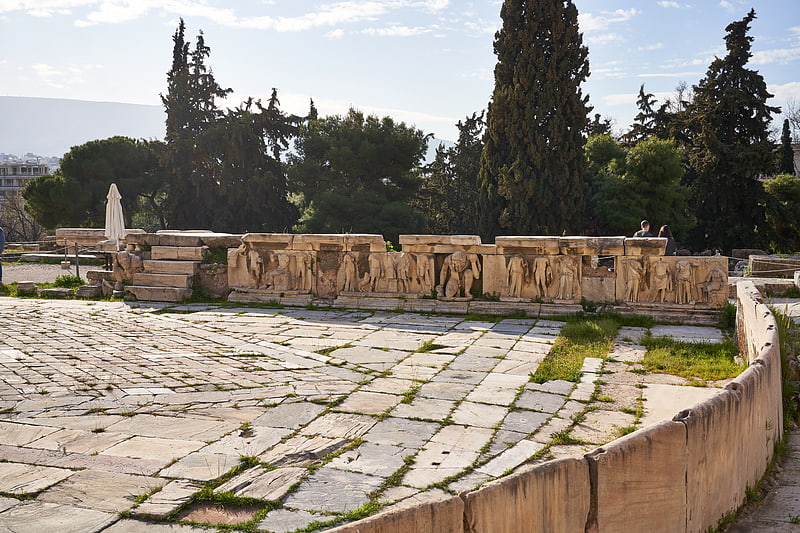
The Bema of Phaidros is the marble platform created in the third century CE that served as stage front to the Theatre of Dionysos in Athens. It is decorated with a Neo-Attic Roman sculpture of the Hadrianic or Antonine period, this sculpture was dismantled sometime in antiquity, moved from an unknown location, and rebuilt into the bema of the Theatre by Phaidros, archon of Athens. Four stone reliefs decorate the stage front illustrating scenes from the life of Dionysos they are: 1) The birth of Dionysos, 2) the entrance of Dionysos into Attica, 3) the sacred marriage of Dionysos and the Basilinna and 4) the enthronement of Dionysos. These scenes are framed by crouching Silenoi.
The sculpture, reading the viewer's from right to left, begins with a scene that can be taken to be the birth of Dionysos. It consists of four figures beginning with a semi-draped seated figure who is likely Zeus facing him is a youth holding a small child, presumed to be Hermes and the infant Dionysos at the moment of his second birth from the thing of Zeus. Framing the scene are two nude male figures each holding a shield, these have been conjectured to be either korybantes or kouretes. The next slab represents the bestowing of the gift of wine, the introduction of the worship of Dionysos to Attica and alludes to the beginnings of tragedy. Again there are four figures; reading right to left they are, a young male figure in a chlamys and lion skin gesturing to his right. Immediately next is a figure identified by his attributes of grapevine, leopard skin and cothurni as Dionysos. Between him and the adjacent figure to his right is a small altar, this latter figure may be Ikarios accompanied by his dog Maera and a tethered goat. To the viewer's left is a draped female, possibly a maenad, sometimes identified as Erigone On the third slab are three figures with a fourth figure lost over time, they are conjectured to be, from left to right, Tyche Dionysos and Basilinna. The final slab on the viewer's far left consists perhaps of, from left to right, Tyche, Theseus, Basilianna, and Dionysos enthroned.
It is evident from the way in which the sculptures have been cut down in size to fit their present placement, and for chronological reasons, that they are reused, secondary material. No conclusive solution has been put forward for the original date or location of the sculptures, though it has been suggested that they may have been meant for the scaenae frons of the high pulpitum built during the first half of the second century.[27]
Gazi
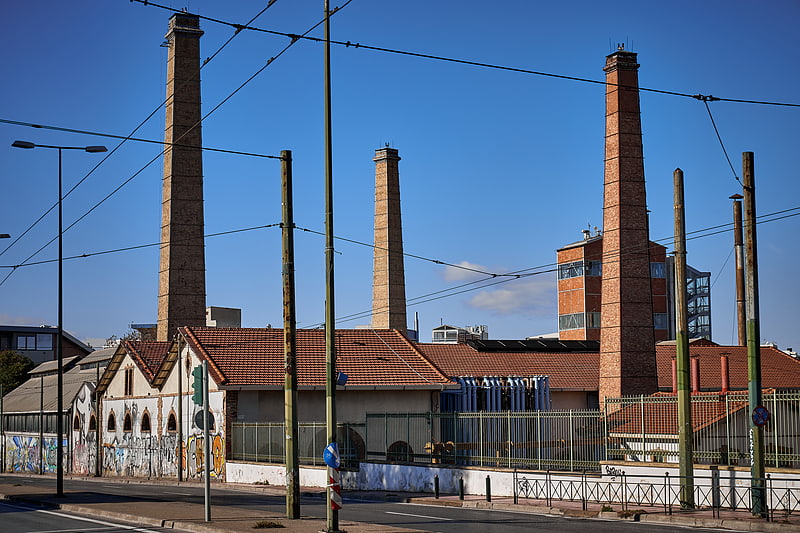
Also known as: Γκάζι
Neighborhood in Athens, Greece. Gazi is a neighborhood of Athens, Greece. It surrounds the old Athens gasworks, which is the industrial museum and exhibition space "Technopolis", widely known as Gazi, next to Keramikos and close to the Acropolis.[28]
Philopappos Monument

Also known as: Μνημείο Φιλοπάππου
Monument ruins from the 2nd century. The Philopappos Monument is an ancient Greek mausoleum and monument dedicated to Gaius Julius Antiochus Epiphanes Philopappos or Philopappus, a prince from the Kingdom of Commagene. It is located on Mouseion Hill in Athens, Greece, southwest of the Acropolis.[29]
Pedestal of Agrippa
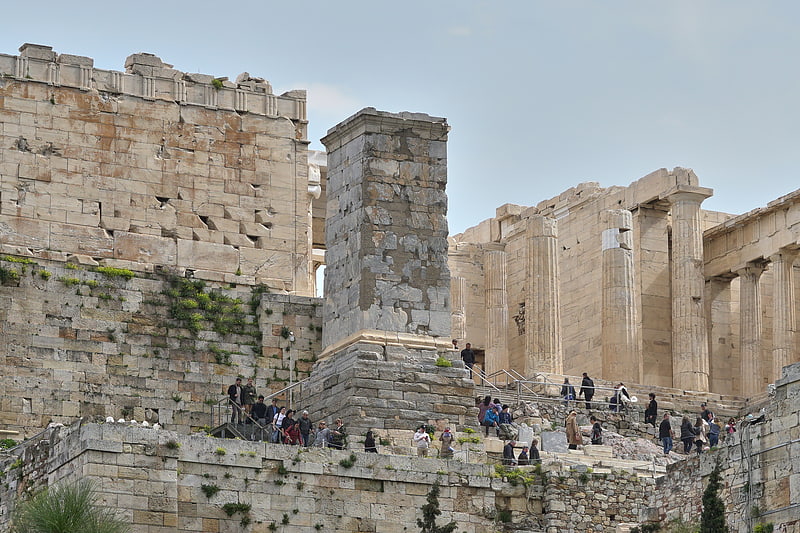
Historical landmark in Athens, Greece. The Pedestal, now known as the Agrippa Pedestal located west of the Propylaea of Athens and the same height as the Temple of Athena Nike to the south, was built in honor of Eumenes II of Pergamon in 178 BC to commemorate his victory in the Panathenaic Games chariot race. Its height is 8.9 meters. It was the base of a bronze quadriga, life-size, probably driven by Eumenes and/or his brother Attalus II. Towards 27 BC this chariot was replaced by another one, dedicated by the city of Athens to Marcus Agrippa, son-in-law of Augustus, in recognition of the reconstruction of the Odeon of Athens in front of the Agora of Athens; It disappeared on an unknown date.[30]
Brauroneion
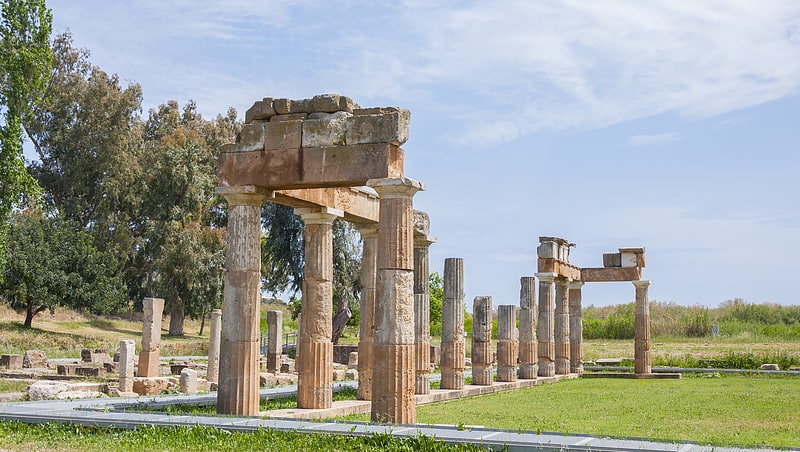
Also known as: Βραυρώνιον
Historical landmark in Athens, Greece. The Brauroneion was the sanctuary of Artemis Brauronia on the Athenian Acropolis, located in the southwest corner of the Acropolis plateau, between the Chalkotheke and the Propylaea in Greece. It was originally dedicated during the reign of Peisistratos. Artemis Brauronia, protector of women in pregnancy and childbirth, had her main sanctuary at Brauron, a demos on the east coast of Attica.
The sanctuary on the Acropolis was of an unusual trapezoidal shape and did not contain a formal temple. Instead, a portico or stoa served that function. The stoa measured circa 38 by 6.8 m; it stood in front of the southern Acropolis wall, facing north. At its corners, there were two risalit-like side wings, each about 9.3 m long, the western one facing east and vice versa. North of the east wing stood a further short west-facing stoa. All of the sanctuary's western part, now lost, stood on the remains of the Mycenaean fortification wall. All that remains of the eastern pare are foundations for walls, cut into the bedrock, as well as some very few architectural members of limestone.
One of the wings contained the wooden cult statue (xoanon) of the goddess. Women who petitioned Artemis for help habitually dedicated items of clothing, which were draped around the statue. In 346 BC, a second cult statue was erected. According to Pausanias, it was a work by Praxiteles.
Pausanias wrote:
There is also a sanctuary of Artemis Brauronia (of Brauron); the image is the work of Praxiteles, but the goddess derives her name from the parish of Brauron. The old wooden image is in Brauron, Artemis Tauria (of Tauros) as she is called.
Pausanias also records the presence of an over-life-sized bronze horse representing the Trojan Horse.
Then there is a sanctuary of the Brauronian Artemis.. The horse one sees here, referred to as wooden, is in bronze.. But tradition has it that inside that horse were hidden the most valiant of the Greeks, and indeed the design (schema) of the bronze figure fits in well with this story. Menestheus and Teucer are peeping out of it, and behind them also the sons of Theseus.
Further evidence is provided by the scholion to Aristophanes mentioning the name of the dedicator, Chairedemos. This is corroborated by the survival of the base of the sculpture on the Acropolis, which is inscribed with the names of Chairedemos and its sculptor Strongylion. The reference in Aristophanes allows for a terminus ante quem of the statue of 415/414.
The entrance to the small sacred precinct, near its northeast corner, is still marked by seven rock-cut steps. They, and its northern enclosure, were probably created by Mnesicles during the building of the Propylaea. The date of the complex in its final shape is unclear, but a date around 430 BC, similar to that of the adjacent Propylaea, is commonly assumed.
If still in use by the 4th-century, the temple would have been closed during the persecution of pagans in the late Roman Empire, when the Christian Emperors issued edicts prohibiting non-Christian worship.[31]
Zappeion
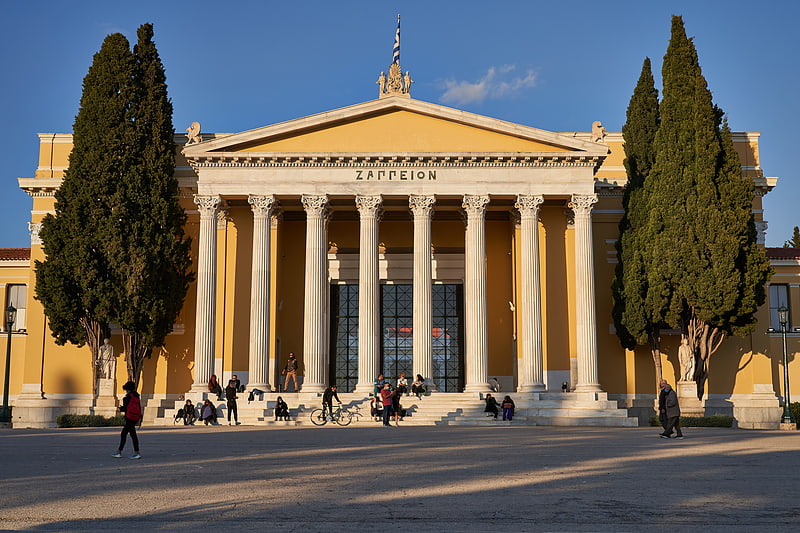
Also known as: Ζάππειον Μέγαρο
Grand 1880s hall with Olympic history. The Zappeion is a large, palatial building next to the National Gardens of Athens in the heart of Athens, Greece. It is generally used for meetings and ceremonies, both official and private and is one of the city's most renowned modern landmarks.[32]
Address: Βασιλίσσης Όλγας, 105 57 Αθήνα (Αθήνα 1)
Pnyx
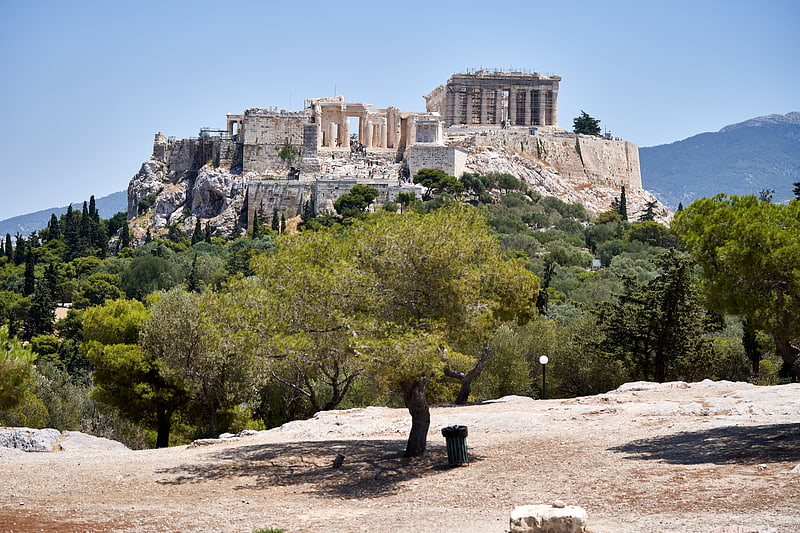
Also known as: Πνύκα
Hill in Greece. The Pnyx is a hill in central Athens, the capital of Greece. Beginning as early as 507 BC, the Athenians gathered on the Pnyx to host their popular assemblies, thus making the hill one of the earliest and most important sites in the creation of democracy.
The Pnyx is located less than 1 kilometre (0.62 mi) west of the Acropolis and 1.6 kilometres (0.99 mi) south-west of the Syntagma Square in the centre of Athens.[33]
Klepsydra
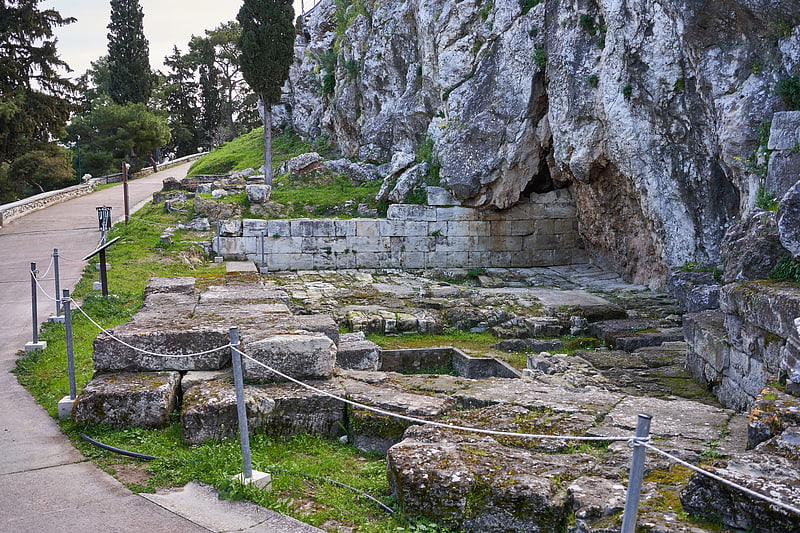
The Klepsydra of the Acropolis of Athens is a natural spring on the north-west slope of the Acropolis hill, near the intersection of the Peripatos and the Panathenaic Way. It had been in use as a source of water since prehistoric times but sometime in the fifth century BCE the site was developed with several new structures built. The site consisted of the paved court, a well, the covered well-house, a later Roman apsidal well house and a flight of stone-carved steps up to the propylaea. There are several references to the source in ancient literature; Hesychius says of it “Klepsydra is a fountain which was formerly called Empedo”. Empedo, argues Parsons, was the name of the spring and klepsydra the name given to the water made available by the fountain house. It would seem that Empedo was also the name of the tutelary deity of the spring - an Attic nymph. Mention is also made of the fountain by Aristophanes, Pausanias, and Plutarch.
It was Stuart and Revett who first identified the free-flowing stream on the face of the hill with the klepsydra mentioned by the ancient authors. During the period of Frankish control, the klepsydra was heavily fortified, however, during the long period of Ottoman occupation the well fell into disuse such that the Turkish garrison of the Akropolis was forced to surrender at the siege of 1822 due to the lack of water. Kyriakos Pittakis rediscovered the source of the spring, leaving the first written account of the site in 1835. Archaeological examination began in earnest with Émile Bturnouf in 1874, and with later development having been cleared from the site Kavvadias uncovered the paved court in 1897. From 1936 to 1940 the American School of Classical Studies at Athens undertook a campaign of excavation, with this the paved court, fountain house and draw basin were fully exposed. It was from this final excavation that it was determined that the spring house had been set into a natural cave which had collapsed sometime in antiquity. A shaft was then opened into the well directly accessible from the Akropolis and a new well house constructed above in the Roman period. From potsherds recovered it was ascertained that the original Greek fountain house was built not earlier than 475-470 BCE.[34]
Peripatos

The Peripatos is an ancient pathway that girds the Acropolis in Athens and intersects with the Panathenaic way on the north slope. It connects the shrines that are interspersed around the Acropolis hill. A reading of Thucydides 2.17, which records that the shrines were erected within an area which it was forbidden to build or quarry called the Pelasgian ground, suggests that the peripatos follows the line of the archaic and now vanished Pelasgic wall.
An inscription on a boulder of acropolis limestone from the north slope of the hill is the only epigraphic evidence of the pathway. It reads "Length of the Peripatos: five stades and eighteen feet." This inscription is dated to the fourth century BCE, though it is possible that the path had been cleared and in use at least since the Periklean building programme by when the cave sanctuaries had been established. Pausanias in the second century CE makes mention of using the road to examine the klepsydra and the Apollo cave.
Work was undertaken to restore the Peripatos beginning in 1977.[35]
Address: Peripatos, Athens (Αθήνα 1)